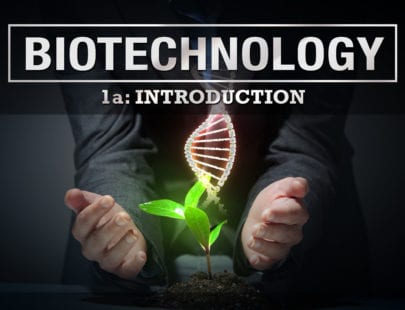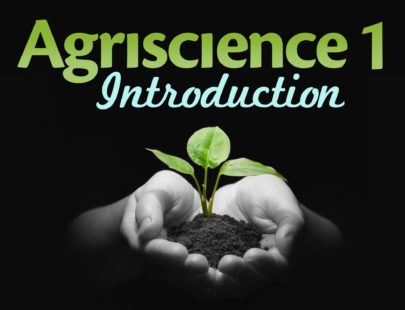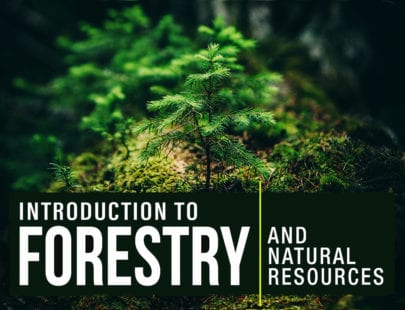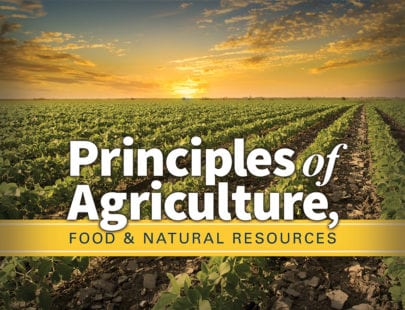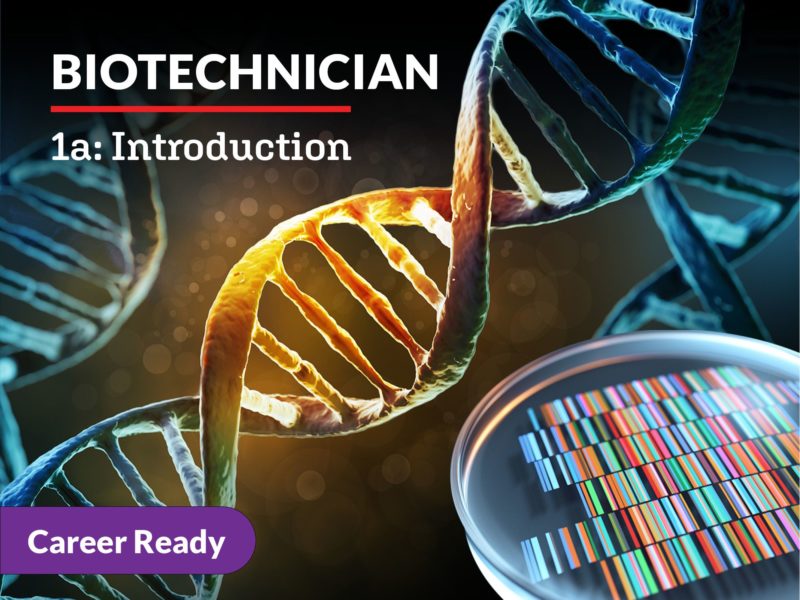
Biotechnician 1a: Introduction
There are so many mysteries that need unraveling in the world today that can help us grow better crops, cure diseases, combat pollution, solve crimes, and so much more. If you love the idea of solving problems to make the world a better place, a career as a biotechnician may be for you. In this course, you’ll learn the basics of lab safety, how to perform tasks crucial to experimentation, biological basics, and about the exciting careers available in the field of biotechnology. Not all heroes wear capes. Some wear lab coats. Grab yours and let’s get started!
Units at a Glance
Unit 1: Introduction to Biotechnology
What do cloned pets, cancer-seeking nanorobots, drug-producing produce, spider goats, lab-grown organs, meatless meat, and explosive-eating microbes all have in common? They are all produced through biotechnology! You will be amazed at all the ways that biotechnology has impacted your life and the world around you. Let’s take some time to learn what biotechnology is, how it developed, and where it might take us in the future. After considering an overview of the many fields and careers available in biotechnology, you’ll be able to make some informed choices about which area interests you most.
What will you learn in this unit?
- Define biotechnology and explain applications of biotechnology to your life
- Identify important historical milestones and advancements in the field of biotechnology
- List the different fields of biotechnology and give examples of significant advancements in each area
- Explain the bioethical issues related to biotechnology and identify potential societal impacts of advancements in this field of science
- Explore a career of interest in the biotechnology field.
Unit 2: Biotechnology Laboratory Safety
What do virus hunters, biological weapons manufacturers, and biotechnicians all have in common? Unfortunately, they share the risk of potentially contracting a deadly disease when they go to work. Sound scary? Well, if you are well trained and commit to following proper laboratory safety guidelines and regulations, working in a biological laboratory -even one with harmful or deadly organisms – should be perfectly safe. So, what are important safety guidelines, regulations, practices, and procedures you need to know? Let’s jump in and find out.
What will you learn in this unit?
- Explain the importance of understanding laboratory safety and describe the main steps to follow to prevent laboratory accidents
- Identify the hazard posed by a chemical or biological agent using a safety sign or symbol
- Describe the most important safety equipment and personal protective equipment (PPE) to use when working with different types of hazardous materials
- Analyze a safety data sheet to determine the safety hazards associated with a particular chemical, the most appropriate PPE and safety equipment to use, as well as the best method to safely handle, store, and dispose of the chemical
Unit 3: Biosafety and Sterility
Pathogens, disease, germs, bugs, microorganisms, viruses, fungus, bacteria . . . no matter what you call these organisms, biotechnologists work with them, study them, and even try to prevent them from contaminating their experiments. How do they do this safely? How can they mitigate the harm microorganisms can cause in research? Following important protocols and techniques while performing their work is key. But, what protocols and techniques must they follow? Here, we’ll take a closer look to find out.
What will you learn in this unit?
- Compare and contrast the four biosafety levels, determine the biosafety level of biological organisms and materials, and identify the PPE, lab, and facility requirements, at each level
- Explain the importance of following aseptic techniques and protocols in biological laboratories
- Determine the correct method or tool that should be used to sterilize or disinfect laboratory equipment, workspaces, and materials
- Differentiate between proper and poor aseptic technique when performing basic laboratory procedures
Unit 4: Biotechnology By The Numbers
How big, or rather small, is biotechnology? How big is a strand of DNA, an enzyme, or an antibody? How do you work with the raw materials of biotechnology at such a small scale? Here, you will learn how to use the standard equipment and units found in nearly every biotechnology-based laboratory; you will also be able to perform important calculations and accurately use that equipment when you step into a research laboratory for the first time.
What will you learn in this unit?
- Clearly convert, calculate, and report measurements and calculations used when working in the lab
- Prepare molar, % concentration, and mass/volume solutions
- Demonstrate correct use of a micropipette
- Identify and describe the proper use of basic equipment found in a biotechnology laboratory
Unit 5: The Molecule of Life
Think for a moment about all the different types of life that exist on our planet. It might be surprising to know that the basic blueprint for this life is found in a tiny molecule, DNA. Here, you will learn how mankind discovered DNA, how it is structured, and how this new knowledge was applied in science. You’ll get a chance to zero in on this amazing molecule, learning how to identify some of the specific information it uncovers.
What will you learn in this unit?
- Summarize the experiments that led to our understanding that DNA, not protein, is the molecule of hereditary
- Describe the structure of DNA in detail and explain how this new information was applied in science
- Understand and interpret a DNA profile
- Make a DNA profile
- Identify and label the steps of DNA replication
- Compare and contrast PCR with DNA replication
Unit 6: Gene Expression
Our bodies must constantly respond to changing conditions. Something as simple as eating a meal poses a potentially dangerous condition if blood glucose concentrations are not returned to normal shortly thereafter with the help of the protein, insulin. In fact, proteins are involved in nearly every cell process in the body. They give us our traits, serve as a source of energy, perform cellular repair, form blood cells, allow for healthy growth and development, and even play a role in our immune system. Here, we’ll learn how proteins are made by the cell, the structure and function of these proteins, and how scientists study and use them in research.
What will you learn in this unit?
- Describe the process in which proteins are produced through transcription and translation
- Discuss the process in which proteins are developed through translation.
- Understand the role of protein structure on its function and identify the primary, secondary, tertiary, and quaternary structure of proteins
- Outline the steps scientists use to study protein structure as well as purify and separate proteins in the lab
- Analyze the impacts of enzyme action on the rate of a chemical reaction using graphical data
Unit 7: Genomics and Precision Medicine
Are you interested in the past? Have you ever wondered where your ancestors came from? How about the future? Do you wonder if you will live for 100 years or develop a fatal disease right in the prime of your life? The answers to some of these questions can be found within your own DNA. Once scientists discovered the important function of DNA, they set about dissecting and decoding it. What could this hidden cache of information reveal to us? How could we use the information to understand our own health and improve the way we treat disease? Let’s find out.
What will you learn in this unit?
- Describe what your genome is and why studying your genome (genomics) is important
- Discuss the impact genomics can have on you
- List applications of precision medicine and types of genetic testing
- Understand the benefits and challenges of direct-to-consumer testing
- Compare and contrast different types of DNA sequencing technologies
- Identify the best method to use to perform DNA isolation and extraction and compare the benefits and drawbacks of each type
Unit 8: Experimental Design
Experimental design is at the heart of all scientific disciplines. The field of biotechnology has made so many advancements and great strides due to scientists asking important questions, setting up sound experimental designs to test their questions, and making sense of the data they collect. Here, you will learn about and practice the scientific method as you ask and use bioinformatics to answer a meaningful question related to DNA barcoding technology.
What will you learn in this unit?
- Ask a meaningful research question, write a testable hypothesis, and design an experiment to test the hypothesis
- Document your work in a legal laboratory notebook according to industry standards and guidelines
- Compare and contrast traditional taxonomy with DNA barcoding in the methods followed to perform each, the advantages and disadvantages of each, and the applications
- Use a bioinformatics database to analyze DNA sequence data
Required Materials
Physical
- 1 small packet of Agar-agar powder (you can get it at many Asian food markets or on Amazon).
- 12 inches of (16 in gauge) stainless-steel wire or copper wire (all metal)
- 2 alligator clips with wires
- 2 small, transparent cups
- 3 packets of concentrated (unsweetened) Kool-Aid of your favorite flavors and sugar
- 5 9v (9 volt) batteries
- 70-95% Isopropyl Alcohol (Rubbing Alcohol)
- Aluminum foil
- Baking soda
- Balance
- Black Pen
- Black Sharpie
- Cheesecloth
- Chemical disinfectant (or fake bottle)
- Composition notebook
- Container with a lid
- Corn syrup
- Cotton swabs
- Dish
- Distilled water
- Five – 9 volt batteries
- Flat container
- Food color
- Friend or family member
- Funnel
- Gel comb or flathead screwdriver
- Glasses or Cups
- Individually wrapped small candy bars (12)
- Jars or containers with food coloring and water
- Knife
- Liquid Food Coloring (3-4 different colors) with screw cap
- Measurement tools
- Measuring cups and measuring spoons
- Micropipette
- Micropipette tips
- Microwave
- Milk (2% or higher fat content)
- P20 micropipette
- Paper towels
- PPE: Rubber gloves, safety glasses, laboratory coat
- Printer
- Resealable plastic bag
- Ruler
- Safety glasses
- Salt
- Scale
- Scissors
- Sharp knife
- Small Tupperware container
- Spoon
- Strawberries
- Sugar
- Tall drinking glass
- Tape
- Toothpicks
- Tweezers or wooden skewer
- Video recording device
- Volumetric measuring devices such as a beaker, graduated cylinder, measuring cup, or tablespoon
- Water
- Wax paper or aluminum foil.
- White paper
- Writing utensil
Software
- Presentation software
- Word processing software
Optional
- Friend or family member
- Pretend Autoclave
- Pretend Bunsen burner
- Videoconferencing software
